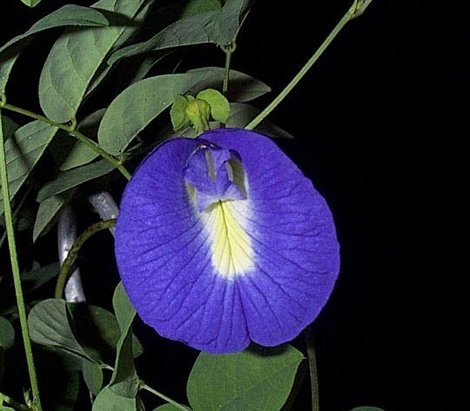Daeng Chan As an Ancient Hair Remedy

Daeng Chan, presently known in the West as the Butterfly Pea, Blue Pea, or Pigeon Wings, is a beautiful climbing plant of the Papilionaceae family. Popular among gardeners due to its lovely blue blossoms, Daeng Chan is praised as an ancient Oriental hair remedy. Native to Asia and, perhaps, South America, Butterfly Pea first gained its reputation as a powerful hair strengthener in the traditional Thai medicine.
Since the 17th century, Daeng Chan has been cultivated in many parts of the world, including India, Europe, and tropical regions. Its enchanting flowers, which only last a day when blossoming, have long been incorporated into food-colouring, and especially to give bluish shades to rice dumplings and sweets. Daeng Chan is known to enrich the levels of nitrogen in the soil where it grows, but is mostly cultivated nowadays as an ornamental plant. However, its qualities of a folk medicinal remedy able to combat hair loss and restore natural hair colour cannot be underestimated.
In the old days, Thai women used Daeng Chan to make a herbal medicine capable to cure baldness. Due to its unique strengthening properties, high protein content, and other, still unidentified, medicinal powers, Daeng Chan was very effective in strengthening the hair roots, improving blood circulation in the hair follicles, and promoting an additional flow of nutrients and oxygen in the scalp. Another quality of Daeng Chan is to treat hair that has become prematurely grey. Natural hair-care products that contain Butterfly Pea have a whole range of beneficial effects that stimulate hair to regain its thickness, softness, and original colour.
Traditionally, home-brewed Daeng Chan extracts were mixed with rice water and used as natural hair shampoos. Freshly-squeezed Daeng Chan juice was applied on babies’ and children’s heads to promote the growth of thick, healthy hair. Aging women were treating their greyish hair with Daeng Chan juice that was able to revive a deep black hue of their locks. Extracts of this wonder plant were even used to restore the growth and increase the thickness of eyelashes and eyebrows!
Now we know that Daeng Chan is full of powerful antioxidants and beneficial phytochemicals, while ancient healers used to notice that it was thriving beautifully in the heat and direct sunlight, untouched by insects or common plant illnesses. They believed that the strength and endurance of this plant could be transferred to people, and especially make weakening hair become strong and thick again.
Unique flowers of Butterfly Pea contain a naturally-occurring beneficial substance called anthocyanin. When applied on the scalp, anthocyanin works to intensify the circulation of oxygen and various nutrients that nourish the hair roots. Increased circulation also provides additional nourishment for the hair follicles and give them a powerful boost to enter a fast-growth phase.
Due to its ability to strengthen, darken, and thicken hair, Butterfly Pea has recently attracted attention of the cosmetic industry. It can now be found in some commercially available hair shampoos, dyes, and conditioners. However, if you want to obtain really dramatic results in combating hair loss with Daeng Chan, try more powerful home-made infusions of this wonderful plant. It could be brewed, juiced, added to vinegars, or incorporated into oils. Especially effective is a Butterfly Pea infusion in extra-virgin olive oil, which can be used for a weekly scalp massage to restore and regrow your hair.
Christiana Roberts
Posted on March 27, 2008
Filed Under Hair Care, Hair Loss Treatments
Comments
One Response to “Daeng Chan As an Ancient Hair Remedy”
Leave a Reply

Where can this plant be purchased in the US or how would I obtain this plant from Overseas?